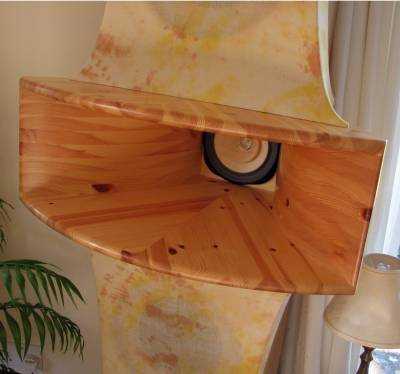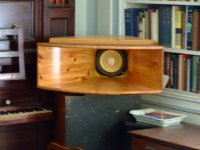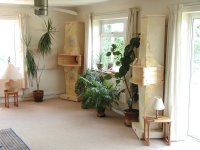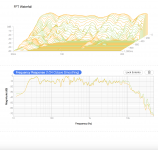TP1s - I've been a glutton for this genre of speaker - all in the name of science, of course, as it's actually in trying one configuration and another that one begins to understand the acoustics.
I've been playing with the original TP1A where the unit faces down and has a reflector into the horn. This is a great arrangement as the suspensions are evenly loaded by gravity, naturally rather than having to cope with the lateral forces of being vertically mounted. This speaker needs the doorknob phaseplugs. The doorknobs reflect treble laterally into the horn, at rightangles to the speaker, as well as providing an exponential profile horn loading the voice coil between the whizzer and the phaseplug. The modern units I've seen photos of are too far forward out of the cone and are not of the right profile and as a result the proper horn loading bringing equality to the frequency range has been lost, causing the need for the roll back whizzer surrounds to supress a resonance, and making the sound fuzzy with internal reflections back down the back of the whizzer. The cone should be straight with no roll-back - and this can be done with a slit from a knife and flipping it forward.
I've been playing with the TP1 London in its original form with its 500Hz front horn and in its Imperator form with the 150Hz front horn.
All these units do well with a DX4, EX4 or PM5 rather than PM2. The unit and the phase plug of for the London and Imperator make more difference than the difference in front horn. In my pair the best phaseplug is the standard bullet. With this the sound is very very very close to the TP1A with either DX4 or PM5 and doorknob.
But I have a pair of wooden front horns which are just 150Hz horns made by John Richardson

and these work best with the doorknobs.
The TP1A has great bass extension but not bass efficiency. I turn up the bass on my amplifier to compensate and a bass drum can catch one very unawares. The Londons/Imperators would respond similarly but I simply augment the bass with a pair of Acoustas fed by 7mH coils and in parallel with a pair of Tannoy DC2000s but anything would do . . . For the Richardson horns I face the Acousta into the corner of the room so that the horn is extended and have added a pair of Tannoy 913s in addition. The horns are fed through a 100uF capacitor and the bass augmentation through a 7mH inductor.
The 7mH inductors might well be 3.5mH - from memory I have forgotten which I used.
The bass of the Wordens is not as good - but they are nevertheless excellent and would probably respond well to a sub-bass extension such as I use with TP1s. Whereas the TP1s do respond without the extra reinforcement simply on amplification, on account of the efficiency of horn loading, working well, the Wordens do not have the privilege of the horn loading and so becoming bass radiators in the bottom end are subject to doppler distortion and muddiness of any conventional speaker. Were one to look at clean full orchestra therefore, in comparison to the TP1s which are clean right through, the Wordens would benefit more from the sub-bass reinforcement.
The reflector area of the front of the Wordens give them a big sound, and it's amusing to see people's reaction when they see the small unit inside.
I recall an experience hearing a pair of Tannoy 15inch units a long time ago and the Wordens certainly give that impression of the size of radiating area.
Best wishes
David P
Attached is a photo of the Richardson production horns in his living room
I've been playing with the original TP1A where the unit faces down and has a reflector into the horn. This is a great arrangement as the suspensions are evenly loaded by gravity, naturally rather than having to cope with the lateral forces of being vertically mounted. This speaker needs the doorknob phaseplugs. The doorknobs reflect treble laterally into the horn, at rightangles to the speaker, as well as providing an exponential profile horn loading the voice coil between the whizzer and the phaseplug. The modern units I've seen photos of are too far forward out of the cone and are not of the right profile and as a result the proper horn loading bringing equality to the frequency range has been lost, causing the need for the roll back whizzer surrounds to supress a resonance, and making the sound fuzzy with internal reflections back down the back of the whizzer. The cone should be straight with no roll-back - and this can be done with a slit from a knife and flipping it forward.
I've been playing with the TP1 London in its original form with its 500Hz front horn and in its Imperator form with the 150Hz front horn.
All these units do well with a DX4, EX4 or PM5 rather than PM2. The unit and the phase plug of for the London and Imperator make more difference than the difference in front horn. In my pair the best phaseplug is the standard bullet. With this the sound is very very very close to the TP1A with either DX4 or PM5 and doorknob.
But I have a pair of wooden front horns which are just 150Hz horns made by John Richardson
and these work best with the doorknobs.
The TP1A has great bass extension but not bass efficiency. I turn up the bass on my amplifier to compensate and a bass drum can catch one very unawares. The Londons/Imperators would respond similarly but I simply augment the bass with a pair of Acoustas fed by 7mH coils and in parallel with a pair of Tannoy DC2000s but anything would do . . . For the Richardson horns I face the Acousta into the corner of the room so that the horn is extended and have added a pair of Tannoy 913s in addition. The horns are fed through a 100uF capacitor and the bass augmentation through a 7mH inductor.
The 7mH inductors might well be 3.5mH - from memory I have forgotten which I used.
The bass of the Wordens is not as good - but they are nevertheless excellent and would probably respond well to a sub-bass extension such as I use with TP1s. Whereas the TP1s do respond without the extra reinforcement simply on amplification, on account of the efficiency of horn loading, working well, the Wordens do not have the privilege of the horn loading and so becoming bass radiators in the bottom end are subject to doppler distortion and muddiness of any conventional speaker. Were one to look at clean full orchestra therefore, in comparison to the TP1s which are clean right through, the Wordens would benefit more from the sub-bass reinforcement.
The reflector area of the front of the Wordens give them a big sound, and it's amusing to see people's reaction when they see the small unit inside.
I recall an experience hearing a pair of Tannoy 15inch units a long time ago and the Wordens certainly give that impression of the size of radiating area.
Best wishes
David P
Attached is a photo of the Richardson production horns in his living room
Attachments
I have just returned to this thread and found details of the John Richardson horns

"Prophecy Audio" Prophecy Audio horn loudspeakers review - [English]
In the setup of mine I describe above using DX4 drivers and door-knob phase plugs everyone is blown away by the clarity and reality of the sound. Reality - a recording of a piano sounds as though the piano is there, and is not a recording reproduction. All other programme material too.
Being a pragmatist and a physicist by training, I'm not a fan of snake-oil. I use a bog standard cheap Technics transistor amplifier (antithump switch-on protection is all that is important with Lowther drive units) and connexions are made with standard 2.5mm T&E mains cable.
Best wishes
David P

"Prophecy Audio" Prophecy Audio horn loudspeakers review - [English]
In the setup of mine I describe above using DX4 drivers and door-knob phase plugs everyone is blown away by the clarity and reality of the sound. Reality - a recording of a piano sounds as though the piano is there, and is not a recording reproduction. All other programme material too.
Being a pragmatist and a physicist by training, I'm not a fan of snake-oil. I use a bog standard cheap Technics transistor amplifier (antithump switch-on protection is all that is important with Lowther drive units) and connexions are made with standard 2.5mm T&E mains cable.
Best wishes
David P
Mine are in storage now 
I had a picture or two at the end of this thread:
http://www.diyaudio.com/forums/subwoofers/206946-extension-subwoofer-lowther-tp1.html
I need to digest your response, lots there!
I had a picture or two at the end of this thread:
http://www.diyaudio.com/forums/subwoofers/206946-extension-subwoofer-lowther-tp1.html
I need to digest your response, lots there!
The Acousta facing into the corner is certainly one solution. The Tannoy 611s are useful as their triangular form fits nicely between an acousta facing into a corner and a wall, or the side of a TP1 and a wall.
Whilst writing, upon more listening hours, the Audio Nirvana is most certainly a good unit for the Wordens.
Best wishes
David P
Whilst writing, upon more listening hours, the Audio Nirvana is most certainly a good unit for the Wordens.
Best wishes
David P
I'm not sure why I am thinking about building more speakers.
That's because when one has a pair of full-range speakers that are natural in sound one doesn't want to hear other rubbish again.
If one enjoys sound, life's too short to listen to rubbish sound. The importance of good full range speakers is not the volume they can go up to but the extent to which the volume can go down and down and down and still reveal all the detail one wants to hear.
The acoustic electromechanical interface is singularly the most important part of the reproduction chain.
In the complexities of transforming mechanical movement of a voice coil to movement of air in different acoustic volume and acoustic space the different strengths of magnet, geometries of cone, phaseplugs or reflectors and impedance transformers in terms of horns all mean that the drive units are horses for courses and have to be chosen for acoustic properties rather than on merit of brand or cost.
When compared the Prophecy front horns are open and are performance quality. The TP1s should be the same, in theory, but sound more claustrophobic, more like speakers but are nevertheless top rate, and the Wordens, effectively having the same spirit of front horn but emanating at the bottom are extremely pleasant and natural.
For the Wordens I'm distinctly favouring the Audio Nirvana Super 8s but am looking forward to sampling the PM6C and also straightening out the rollback cone of the DX4. For TP1s and the Prophecy horns DX or EX4 are appropriate.
Best wishes
David P
I have just managed to get hold of a pair of working Lowther PM6C units and it's these that make the Wordens sing. The bog standard unit with straight whizzer cone and bullet phase plug works outstandingly and brings the excitement back to the music with sweetness too.
I will be returning back to the DX4 units straightening the rolled back whizzer to see if that makes a difference but most certainly the PM6C delivers outstanding performance in these units.
Best wishes
David P
I will be returning back to the DX4 units straightening the rolled back whizzer to see if that makes a difference but most certainly the PM6C delivers outstanding performance in these units.
Best wishes
David P
The most important thing in the modern type TP1 is to put acoustic wadding on the 45 degree surfaces behind the unit to stop waves bouncing back reflecting on one surface then the other and then hitting the cone again. That must create a resonance. Many of the Lowther cabinets are improved with judicious use of wadding in the right places to kill standing waves. In the Acousta, the flat surface above the unit needs it as well as the side walls on both sides in the region of the speaker unit. Possibly the containment provided by the EX back might stop the sideways waves re-emerging through the unit cone, but best to kill such a resonance at source by making those surfaces non-reflective.
Best wishes
David P
What do you think about resizing the front end of the horn (placing some blocks in to soak up volume) to support a PM7A (or even the PM4A, assuming the housing brackets would physically fit?)
I currently use 0.5" thick F13 graded wool felt on the entire compression chamber. I am wondering if this is too much felt, but need to probably do some measurements to see where the mid-bass frequency response is currently at.
I currently use 0.5" thick F13 graded wool felt on the entire compression chamber. I am wondering if this is too much felt, but need to probably do some measurements to see where the mid-bass frequency response is currently at.
Last edited:
For the modern TP1s the best units are probably PM5. This has the soft iron pole piece of the PM4 and they fit within the chamber. PM2 were originally specified within the PM3 for the old TP1.
You don't need to fill the back chamber, only kill reflections.
Essential to roll forward the rollback whizzer and fit the lampbulb shaped phase plug.
Best wishes
David P
You don't need to fill the back chamber, only kill reflections.
Essential to roll forward the rollback whizzer and fit the lampbulb shaped phase plug.
Best wishes
David P
Lowther PM5A
Actually, the PM5A and PM4A have the same permadur (cobalt steel) pole pieces and face plate, not soft steel like the PM2A.
You can special order Lowther drivers with straight whizzers, like the old design. These do sound best when horn loaded.
I will respectfully disagree on the DX4 v EX4. The back chamber of the EX4 creates reflections that a DX4 is a properly damped compression chamber will not have. The effect is a distinct loss of clarity in some notes.
Actually, the PM5A and PM4A have the same permadur (cobalt steel) pole pieces and face plate, not soft steel like the PM2A.
You can special order Lowther drivers with straight whizzers, like the old design. These do sound best when horn loaded.
I will respectfully disagree on the DX4 v EX4. The back chamber of the EX4 creates reflections that a DX4 is a properly damped compression chamber will not have. The effect is a distinct loss of clarity in some notes.
Jon - thanks for clarifying on my senility - yes - they are cobalt steel pole pieces rather than soft iron. The effect of the PM5 is to give more top treble than the PM2A and it's aurally important in my opinion.
Yes - I was agreeing with you on EX4vsDX4 but being slightly kind - "best to kill such a resonance at source by making those surfaces non-reflective."
On my EX4 units I have lined the cylindrical section with felt and inserted felt strips on the bare metal between the holes at the back in order to kill reflections.
Possibly in open back horns such as the Prophecy Audio horns and as repeated in spirit by the Mike Wallis design, the EX4's containment of the back wave has a slight advantage if felt is installed in the chamber, but the effect is minimal and possibly inaudible.
Best wishes
David P
Yes - I was agreeing with you on EX4vsDX4 but being slightly kind - "best to kill such a resonance at source by making those surfaces non-reflective."
On my EX4 units I have lined the cylindrical section with felt and inserted felt strips on the bare metal between the holes at the back in order to kill reflections.
Possibly in open back horns such as the Prophecy Audio horns and as repeated in spirit by the Mike Wallis design, the EX4's containment of the back wave has a slight advantage if felt is installed in the chamber, but the effect is minimal and possibly inaudible.
Best wishes
David P
Thanks David and Jon. Looking for some direction in trying something other than the DX4. I am using a First Watt F4 so curious what impedance would be the best match, since I can choose this this time around, as I will be ordering new. Same with voice coil material, etc. In general I have tons of gain so "harder to drive" in a sense would be welcome to add a bit more variance to the volume dial.
David, you would put the PM5 above the EX/DX4, or the best of the A-series?
David, you would put the PM5 above the EX/DX4, or the best of the A-series?
The PM5 is an A . . . it's the largest of the A series that will fit.
There isn't a lot of difference between PM5 and DX4. The main thing that can change the sound is the lamp-bulb phase plug.
This creates an exponential profile between whizzer cone and phaseplug which provides impedence matching through the upper midrange between the efficiency provided by the voice coil at very high frequencies and where the horn of the cabinet makes a difference, so providing a more even spread throughout the system.
Getting accurate sound is nothing to do with whether there's anything spare on the vvolume knob. In fact the joy of these speakers is to be able to turn the volume down and still be able to hear the music.
Best wishes
David P
There isn't a lot of difference between PM5 and DX4. The main thing that can change the sound is the lamp-bulb phase plug.
This creates an exponential profile between whizzer cone and phaseplug which provides impedence matching through the upper midrange between the efficiency provided by the voice coil at very high frequencies and where the horn of the cabinet makes a difference, so providing a more even spread throughout the system.
Getting accurate sound is nothing to do with whether there's anything spare on the vvolume knob. In fact the joy of these speakers is to be able to turn the volume down and still be able to hear the music.
Best wishes
David P
TP1 driver
Will again respectively disagree on EX4 v PM5A. I have had both, and find the PM5A does better with ambiance and low level detail. You must order the PM5A with a non-Hi-Ferric cone to get this effect.
Strangely, the effect is most noticeable on a direct radiator. Horn loading the EX4 makes it sound much better.
The original TP1 used a PM3A. This is a PM2A in a cast iron back chamber. The PM5A has the same size, so it would fit. The PM4A will not.
My preference for the most musical sound is the PM5A. The EX4/DX4 does better at transient response - that is it is "snappier". But the 5A is more relaxed, and has that low level information. That assumes that your front end is up to the task. If you are listening to lesser quality digital the difference is of no consequence.
Will again respectively disagree on EX4 v PM5A. I have had both, and find the PM5A does better with ambiance and low level detail. You must order the PM5A with a non-Hi-Ferric cone to get this effect.
Strangely, the effect is most noticeable on a direct radiator. Horn loading the EX4 makes it sound much better.
The original TP1 used a PM3A. This is a PM2A in a cast iron back chamber. The PM5A has the same size, so it would fit. The PM4A will not.
My preference for the most musical sound is the PM5A. The EX4/DX4 does better at transient response - that is it is "snappier". But the 5A is more relaxed, and has that low level information. That assumes that your front end is up to the task. If you are listening to lesser quality digital the difference is of no consequence.
- Status
- This old topic is closed. If you want to reopen this topic, contact a moderator using the "Report Post" button.
- Home
- Loudspeakers
- Full Range
- Lowther Worden Panasona



